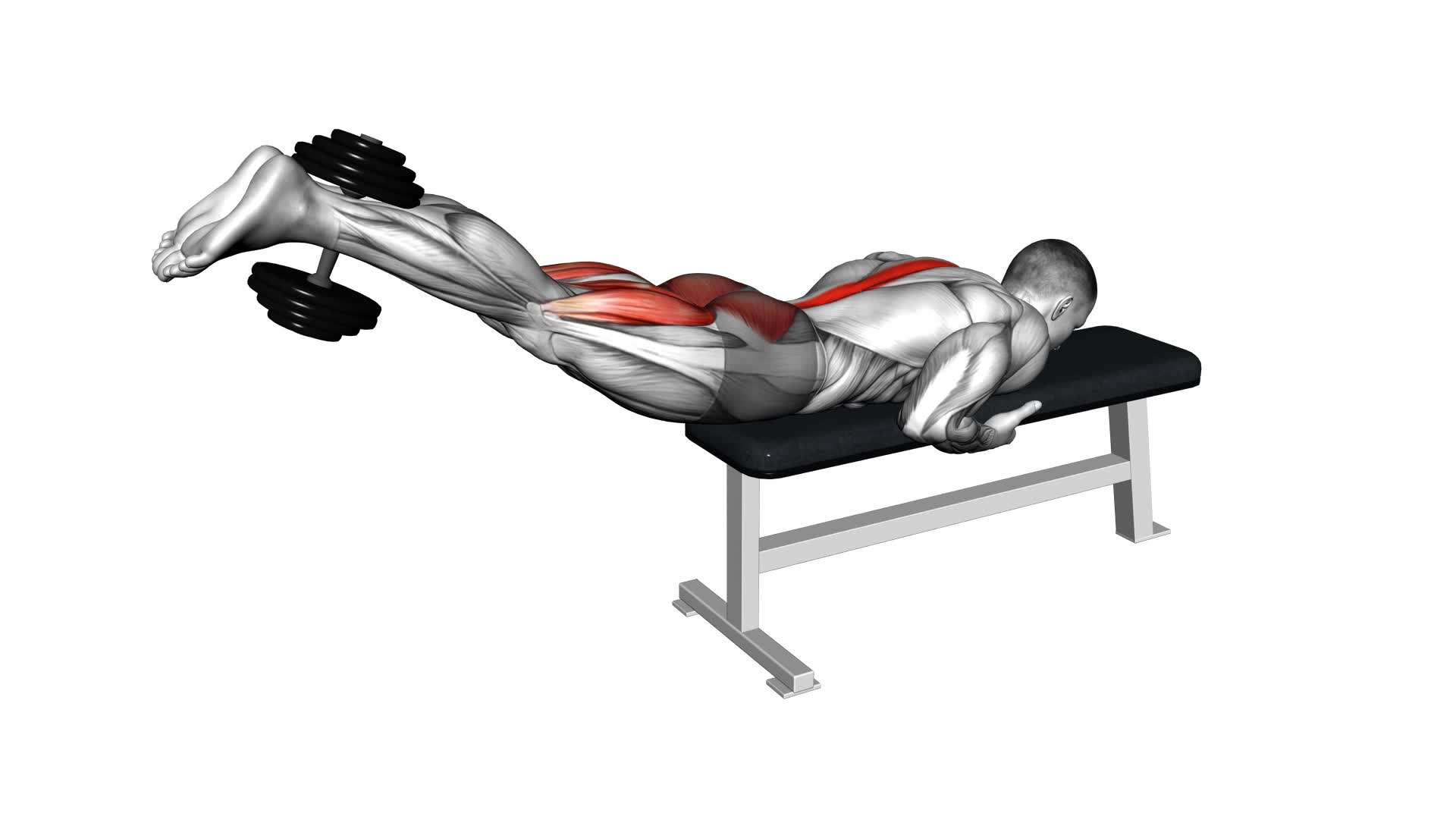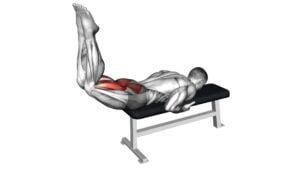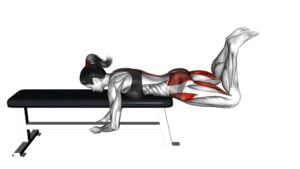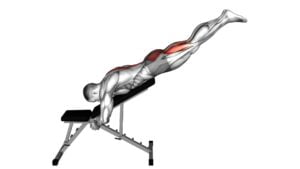Dumbbell Reverse Hyperextension on Bench – Video Exercise Guide & Tips

Are you looking for a challenging exercise to strengthen your lower back and glutes? Then the dumbbell reverse hyperextension on the bench is perfect for you!
Watch This Exercise Video
This exercise targets those muscle groups while also improving core stability.
In this informative video guide, we'll show you the proper form and technique, equipment needed, and provide step-by-step instructions.
Avoid common mistakes and learn valuable tips to maximize your results.
Get ready to take your fitness to the next level!
Key Takeaways
- Dumbbell Reverse Hyperextension strengthens lower back muscles.
- The exercise is effective for injury prevention and muscle activation in the lower back region.
- Engaging the erector spinae muscles reduces the risk of lower back injuries.
- Targeting the gluteus maximus improves stability, strength, and power.
Benefits of Dumbbell Reverse Hyperextension
One of the key benefits of the dumbbell reverse hyperextension is its ability to strengthen your lower back muscles. This exercise is particularly effective for injury prevention and muscle activation in the lower back region.
When you perform the dumbbell reverse hyperextension, you engage your erector spinae muscles, which run along the length of your spine. By strengthening these muscles, you can significantly reduce the risk of lower back injuries. This is especially important for individuals who engage in activities that place a lot of stress on their lower back, such as weightlifting or repetitive bending and lifting.
Additionally, the dumbbell reverse hyperextension targets the gluteus maximus, which is the largest muscle in your buttocks. By activating this muscle, you not only enhance the stability of your lower back but also improve your overall strength and power. This can be beneficial for athletes who rely on explosive movements, such as sprinting or jumping.
Incorporating the dumbbell reverse hyperextension into your workout routine can help you build a strong and resilient lower back, reducing the risk of injuries and improving your athletic performance.
Proper Form and Technique
Follow these steps to perform the dumbbell reverse hyperextension on a bench with proper form and technique.
- Start by lying face down on a bench, positioning your hips just off the edge and allowing your legs to hang freely.
- Hold a dumbbell between your feet, squeezing your legs together to secure it in place.
- Engage your core muscles by pulling your belly button towards your spine.
- Slowly lift your legs upward, focusing on using your glutes and lower back muscles to lift the weight.
- Pause briefly at the top of the movement, ensuring that your legs and torso are in a straight line.
- Slowly lower your legs back down to the starting position, maintaining control throughout the movement.
Proper form and technique are essential when performing the dumbbell reverse hyperextension. By following these steps, you can ensure that you're engaging the correct muscles and maximizing the benefits of the exercise.
Core stability is crucial during the dumbbell reverse hyperextension, as it helps to protect your lower back and maintain proper alignment. Additionally, variations of the exercise, such as using different weights or adding resistance bands, can provide different levels of challenge and target specific muscle groups.
Now that you understand the importance of proper form and technique, let's move on to the next section to discuss the equipment needed for the exercise.
Equipment Needed for the Exercise
To perform the dumbbell reverse hyperextension on a bench, you'll need a dumbbell and a bench. These two pieces of equipment are essential for executing the exercise correctly and safely. The dumbbell provides the resistance needed to target the muscles of the lower back and glutes, while the bench serves as a stable platform for performing the movement.
When it comes to dumbbell reverse hyperextension variations, there are a few options you can consider. If you don't have access to a bench, you can perform the exercise on the floor by lying face down and lifting your legs. Alternatively, you can use a stability ball instead of a bench to add an element of instability and engage your core muscles even more.
If you're looking for alternatives to the dumbbell reverse hyperextension, you can try exercises such as the glute bridge, hip thrust, or back extension. These exercises target similar muscle groups and can provide a challenging workout for your lower back and glutes.
Now that you know the equipment needed for the dumbbell reverse hyperextension, let's move on to the step-by-step guide to performing the exercise.
Step-by-Step Guide to Performing the Exercise
Start by positioning yourself face down on the bench with your legs extended and the dumbbell placed between your feet. Here is a step-by-step guide to help you perform the dumbbell reverse hyperextension on a bench:
- Engage your core muscles and keep your back straight throughout the exercise.
- Slowly lift your legs up towards the ceiling, squeezing your glutes at the top of the movement.
- Pause for a moment at the top, making sure to maintain control.
- Lower your legs back down to the starting position, keeping your movements controlled and smooth.
- Repeat the exercise for the desired number of repetitions.
Now let's talk about some common variations of reverse hyperextension. You can perform this exercise using a stability ball instead of a bench. This variation adds an element of instability, challenging your core muscles even more. Additionally, you can increase the intensity by using a heavier dumbbell or ankle weights.
To modify the exercise for different fitness levels, beginners can start by using lighter weights or no weight at all. As you get stronger, gradually increase the weight or resistance to continue challenging your muscles. Remember to always listen to your body and adjust the exercise as needed.
Common Mistakes to Avoid
Avoiding these common mistakes will help you get the most out of your dumbbell reverse hyperextension on a bench. It's important to focus on proper technique to ensure that you engage the right muscles and avoid any potential injuries. One common mistake to avoid is using too much weight. While it may be tempting to go heavy, using excessive weight can compromise your form and put unnecessary strain on your lower back. Start with a weight that challenges you, but still allows you to maintain proper form throughout the exercise.
Another common mistake is using momentum to lift the weight. This not only takes away from the effectiveness of the exercise, but it also puts your lower back at risk of injury. Instead, focus on using a slow and controlled motion, making sure to squeeze your glutes and hamstrings at the top of the movement.
Lastly, it's important to avoid arching your back excessively. While some natural arch is normal, over-arching can lead to lower back pain and injury. Keep your core engaged and maintain a neutral spine position throughout the exercise.
Tips for Maximizing Results
To maximize your results with the dumbbell reverse hyperextension on bench exercise, it's important to focus on proper form.
Ensure that you maintain a neutral spine and engage your glutes and hamstrings throughout the movement.
Additionally, incorporating progressive overload techniques, such as increasing the weight or reps over time, will help to challenge your muscles and promote growth.
Lastly, don't forget to prioritize recovery and rest periods to allow your muscles to repair and grow stronger.
Proper Form Importance
To maximize your results and ensure proper form, focus on maintaining a strong and stable position throughout the dumbbell reverse hyperextension on bench exercise. This exercise targets your glutes, hamstrings, and lower back, but it's important to prioritize alignment to avoid injury and get the most out of your workout.
Here are some tips to help you maintain proper form:
- Keep your back straight and core engaged throughout the movement.
- Align your shoulders with the bench and maintain a neutral spine.
- Avoid arching or rounding your back.
- Pay attention to your hip position and avoid excessive pelvic tilt.
- Use a controlled and smooth motion, avoiding any jerking or swinging.
Progressive Overload Techniques
To maximize your results and achieve optimal gains, focus on incorporating progressive overload techniques into your dumbbell reverse hyperextension on bench exercise routine. Overload progression is the key to continuous improvement and increased strength.
Start by gradually increasing the weight of the dumbbells you use for the exercise. This will challenge your muscles and force them to adapt, leading to muscle growth. Additionally, you can increase the number of repetitions or sets you perform, or decrease the rest time between sets to increase the intensity of your workout. Intensity management is crucial to prevent plateauing and to continue making progress.
By constantly challenging your muscles with increased weights or intensity, you'll see greater results.
Now, let's move on to the importance of recovery and rest periods in your exercise routine.
Recovery and Rest Periods
Maximize your results and achieve optimal gains by prioritizing proper recovery and rest periods. It's important to understand the significance of active recovery in your training routine. Here are some tips on how to incorporate rest periods into your routine:
- Listen to your body: Pay attention to any signs of fatigue or overtraining. Take rest days when needed to allow your body to recover.
- Plan rest days: Schedule regular rest days into your training program to give your muscles time to repair and grow stronger.
- Vary intensity: Alternate between high-intensity workouts and lighter, recovery-focused sessions to give your body a chance to recover.
- Active recovery: Engage in low-impact activities like swimming, yoga, or light cardio to promote blood flow and aid in muscle recovery.
- Get enough sleep: Quality sleep is essential for proper recovery. Aim for 7-9 hours of sleep each night to support muscle repair and growth.
Frequently Asked Questions
Can I Use a Resistance Band Instead of Dumbbells for the Reverse Hyperextension Exercise?
Yes, you can definitely use a resistance band instead of dumbbells for the reverse hyperextension exercise. Using a resistance band can provide some unique benefits for this exercise. It can help to target and strengthen different muscles in your lower back and glutes.
Additionally, the resistance band allows for a wider range of motion and can increase the challenge of the exercise. So, feel free to switch out the dumbbells and give the resistance band a try!
Is the Dumbbell Reverse Hyperextension Exercise Suitable for Beginners?
The dumbbell reverse hyperextension exercise can be suitable for beginners with proper modifications. It's important to start with lighter weights and focus on maintaining proper form.
This exercise can help strengthen your lower back, glutes, and hamstrings. By using dumbbells, you can increase the intensity and target specific muscles more effectively.
Remember to consult with a fitness professional to ensure you're performing the exercise correctly and safely.
How Often Should I Perform the Dumbbell Reverse Hyperextension Exercise to See Results?
To see results from the dumbbell reverse hyperextension exercise, you should perform it at an optimal frequency. The optimal duration for this exercise depends on your fitness level and goals.
However, it's generally recommended to do this exercise 2-3 times a week. Consistency is key, so make sure to give your body enough time to recover between sessions.
Remember to listen to your body and adjust the frequency as needed.
Can the Dumbbell Reverse Hyperextension Exercise Help With Lower Back Pain?
To help with lower back pain, the dumbbell reverse hyperextension exercise can be beneficial. By strengthening the muscles in your lower back, it can provide support and relief.
However, it's important to note that this exercise should be done correctly and with proper form to avoid further injury.
Additionally, incorporating stretches such as cat-cow, child's pose, and seated forward fold can also help alleviate lower back pain.
Remember to consult with a professional before starting any new exercise routine.
Are There Any Variations of the Dumbbell Reverse Hyperextension Exercise That I Can Try?
There are several variations of the dumbbell reverse hyperextension exercise that you can try. These variations include using different weights, changing the angle of the bench, or incorporating resistance bands.
Each variation targets your lower back and glutes, helping to improve strength and stability. The benefits of the dumbbell reverse hyperextension include building a strong posterior chain, improving posture, and reducing the risk of lower back pain.
Adding these variations to your workout routine can enhance the effectiveness of the exercise.
Conclusion
In conclusion, the dumbbell reverse hyperextension on a bench is an effective exercise for targeting the lower back and glutes. By maintaining proper form and using the correct equipment, you can maximize the benefits of this exercise. Remember to avoid common mistakes and follow the step-by-step guide for optimal results.
Incorporating this exercise into your workout routine can help improve strength and stability in your posterior chain. Keep pushing yourself and enjoy the benefits of this challenging exercise.

Author
Years ago, the spark of my life’s passion ignited in my mind the moment I stepped into the local gym for the first time. The inaugural bead of perspiration, the initial endeavor, the very first surge of endorphins, and a sense of pride that washed over me post-workout marked the beginning of my deep-seated interest in strength sports, fitness, and sports nutrition. This very curiosity blossomed rapidly into a profound fascination, propelling me to earn a Master’s degree in Physical Education from the Academy of Physical Education in Krakow, followed by a Sports Manager diploma from the Jagiellonian University. My journey of growth led me to gain more specialized qualifications, such as being a certified personal trainer with a focus on sports dietetics, a lifeguard, and an instructor for wellness and corrective gymnastics. Theoretical knowledge paired seamlessly with practical experience, reinforcing my belief that the transformation of individuals under my guidance was also a reflection of my personal growth. This belief holds true even today. Each day, I strive to push the boundaries and explore new realms. These realms gently elevate me to greater heights. The unique combination of passion for my field and the continuous quest for growth fuels my drive to break new ground.







